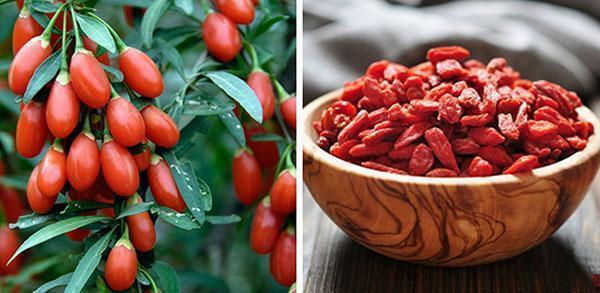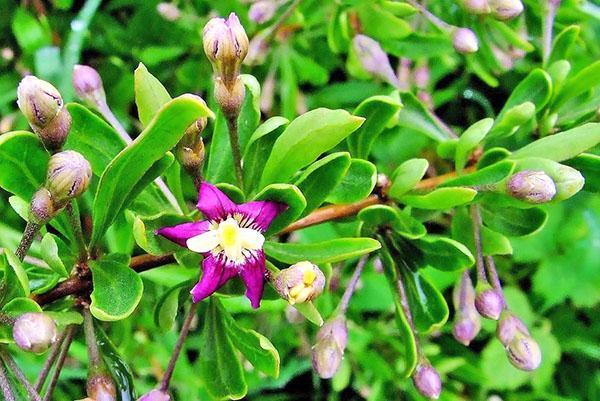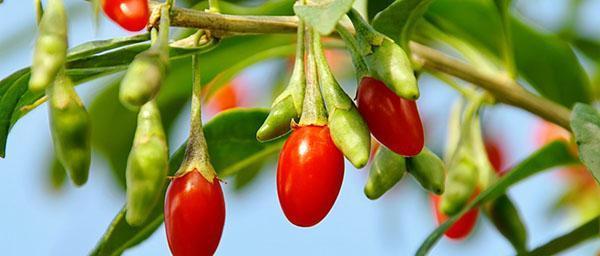An affordable exotic for your gardens - goji berry
 The goji berry fashion is growing at a tremendous rate. Some seek to show their effectiveness with excess weight, while others talk about the colossal beneficial properties and unique vitamin and nutritional composition, which makes berries almost a panacea for many diseases.
The goji berry fashion is growing at a tremendous rate. Some seek to show their effectiveness with excess weight, while others talk about the colossal beneficial properties and unique vitamin and nutritional composition, which makes berries almost a panacea for many diseases.
Botanical reference

In adulthood, the height of the plant reaches 3 m, and the crown is 6 m in diameter (photos of the goji shrub are presented). The branches are drooping and prickly, with small foliage, painted in light green from above, and a bluish tint from below. The root is very strong, growing in the ground, not on its surface.
Flowering begins in June and continues through October with blooming purple, pink, brown-purple buds with a pleasant aroma.
 At the end of flowering, oblong berries of crimson-red or orange color are formed.
At the end of flowering, oblong berries of crimson-red or orange color are formed.
It is categorically impossible to eat fresh fruits, because they contain poisonous components. But after drying, the berries can be used.
Read also about irgi berries!
Goji berries: planting and care in the Moscow region
This is a heat-loving plant, therefore, for the excellent development of goji, care and cultivation must be optimal or close to it. In northern climates, the weather is completely different and efforts must be made to grow berries.
Seat selection
 The plant grows very quickly and at the same time has a well-developed root system. It should be planted either in areas devoid of vegetation, or along the supports to create a hedge.
The plant grows very quickly and at the same time has a well-developed root system. It should be planted either in areas devoid of vegetation, or along the supports to create a hedge.
When choosing a place, you need to be extremely careful, because Dereza can "crush" nearby plants.
It is best to select areas that are sunny or in little shade. In addition, keep in mind that the height of the plant reaches three meters - take care of a reliable support.
Temperature, humidity and soil requirements
As it was said, Dereza is frost-hardy and can withstand temperatures ranging from -26 to + 40 ° C. There are also no special requirements for humidity. Drought tolerant.
The shrub is not capricious to the soil. Alkaline and neutral substrates are preferred. You can also plant a plant in acidic ones, but there it will develop slightly worse.
The only thing that derez does not tolerate is stagnant water. Therefore, you should be very careful when watering and do not plant the plant in areas with a rocky substrate.
Watering and feeding
Tibetan barberry is watered depending on age. In the first year, watering should be no more than twice a week. As the plant grows older, watering can be done less frequently and adjusted for weather and aridity.
Only young animals should be fertilized. For these purposes use superphosphate or humus.After growing into an adult plant, there is no need for top dressing, since Dereza feels great even on very poor lands.
Reproduction
Three methods are used for reproduction.
Seminal
 The seeds are taken from pre-dried berries. To obtain seed, you should take dry fruits, soak them in water and, when they soften, pull out the seeds. For them to grow well, you need to stand in a growth stimulator. After sowing is carried out in a container with a mixture of ordinary earth and peat in a ratio of 1: 2, deepening into the substrate by 2-3 mm.
The seeds are taken from pre-dried berries. To obtain seed, you should take dry fruits, soak them in water and, when they soften, pull out the seeds. For them to grow well, you need to stand in a growth stimulator. After sowing is carried out in a container with a mixture of ordinary earth and peat in a ratio of 1: 2, deepening into the substrate by 2-3 mm.
To maintain the necessary conditions for germination, the container is covered with a film and sent to a warm place inaccessible to light. When the sprouts hatch, the box is taken out into the light and protected from cold and drafts. Watering is carried out from a spray bottle.  After a week, the film can be removed, and when 3-4 leaves are formed, pick (transfer) the seedlings into separate pots (deep).
After a week, the film can be removed, and when 3-4 leaves are formed, pick (transfer) the seedlings into separate pots (deep).
Goji seedlings, grown from seeds at home, are planted on permanently open ground in the spring, when there is confidence that frosts will not return, or already at the beginning of summer.
Planting seedlings
 This option is acceptable if you managed to buy home-grown goji seedlings, or you purchased planting material from your hands.
This option is acceptable if you managed to buy home-grown goji seedlings, or you purchased planting material from your hands.
 With this method, two weeks before disembarkation, holes should be made, 40-50 cm in size. If for the southern regions "harvesting" is carried out in the fall, then for colder ones - in the spring. This will allow the plants to tolerate frost well.
With this method, two weeks before disembarkation, holes should be made, 40-50 cm in size. If for the southern regions "harvesting" is carried out in the fall, then for colder ones - in the spring. This will allow the plants to tolerate frost well.
Coarse sand is poured into each hole and half covered with a substrate consisting of humus and fertile soil, 8 kg each. 30 g of potassium sulfate is also added there (can be replaced with a glass wood ash), 0.15 kg of double superphosphate, mix right in the pit and plant a seedling, sprinkle with fertile soil, and then water. The trunk circle must be mulched using humus or peat.
The trunk circle must be mulched using humus or peat.
The distance between specimens must be at least 2 m.
Cuttings
 Now let's tell you how to grow goji from cuttings. Cuttings 10-12 cm long are cut from an adult plant. Then they are placed in a root-forming solution and planted for rooting in a built greenhouse and put it in a warm place. It is best to plant the material in late July - early August. In the spring, the root will grow enough to plant the goji in open ground. Caring for a young plant does not differ much from an adult.
Now let's tell you how to grow goji from cuttings. Cuttings 10-12 cm long are cut from an adult plant. Then they are placed in a root-forming solution and planted for rooting in a built greenhouse and put it in a warm place. It is best to plant the material in late July - early August. In the spring, the root will grow enough to plant the goji in open ground. Caring for a young plant does not differ much from an adult.
Pruning and wintering
 The shrub needs a regular "haircut". In the first years of growth, 3-6 of the strongest branches are planned. They are taken as a basis and cut around them. Then, on these main skeletal branches, shoots capable of fruiting will begin to form.
The shrub needs a regular "haircut". In the first years of growth, 3-6 of the strongest branches are planned. They are taken as a basis and cut around them. Then, on these main skeletal branches, shoots capable of fruiting will begin to form.
If the tree is grown for decorative purposes, then one main shoot is chosen, a long peg is driven in, and then a "haircut" is carried out, trying to form a tree. The procedure is done as soon as numerous fruiting shoots appear and the total height of the plant exceeds 1.2 m.
 To prevent freezing of the root system in winter, the shrub should be spud and to promulgate by 10-15 cm. The branches are protected with non-woven material (for example, agrofibre, lutrasil) folded in several layers, or with burlap. You can also play it safe, additionally throwing spruce branches over the planting, and, as soon as the snow falls, make large snowdrifts.
To prevent freezing of the root system in winter, the shrub should be spud and to promulgate by 10-15 cm. The branches are protected with non-woven material (for example, agrofibre, lutrasil) folded in several layers, or with burlap. You can also play it safe, additionally throwing spruce branches over the planting, and, as soon as the snow falls, make large snowdrifts.
Pests
The plant perfectly protects itself from pests. Nevertheless, as a preventive measure, you should regularly inspect the wolfberry for the appearance of any signs of disease or pests. If there is such a thing, the affected parts are trimmed and, if necessary, sprayed with insecticidal preparations, diluting them in the amount indicated by the manufacturer on the package. Do not forget that the treatment is done more than once, especially if the invasion of pests is huge.
Application and storage
The collected fruits should be stored in a dry, dark place. If an infusion is being prepared, then it should be kept only in a cool place and no more than 2 days.
 Berries goji used not only for weight loss, but also as an ingredient in the preparation of wines, fruit purees, desserts, soups, pastries, yoghurts, tea, juices, cereals. The seeds are used to make oil. Fresh berries taste like nightshade. But as soon as the fruits are frozen or dried, the taste disappears, and the berries acquire a taste similar to dried apricots.
Berries goji used not only for weight loss, but also as an ingredient in the preparation of wines, fruit purees, desserts, soups, pastries, yoghurts, tea, juices, cereals. The seeds are used to make oil. Fresh berries taste like nightshade. But as soon as the fruits are frozen or dried, the taste disappears, and the berries acquire a taste similar to dried apricots.
In the garden, Dereza is mainly planted to obtain a useful harvest, as well as vegetable hedges. The plant is unpretentious and will not die if you haven't watered or fertilized. But, when planning to plant goji berries on the site, you should consider all varieties in advance and choose the most suitable ones.
Berries are widely used in medicine. So, they are taken for: pain in the back, diabetes, insomnia, anemia, obesity, excess cholesterol, problems with adenoids, vision problems, athletes thus restore their strength, etc.
As you can see, although goji berries are an exotic shrub, you don't need to go to overseas countries or buy them at a fabulous price. It is enough to observe some of the nuances, and you can easily grow a plant in your area and collect a very considerable harvest.